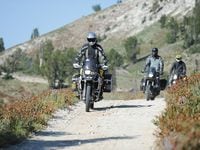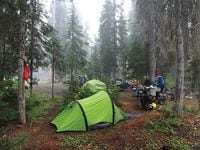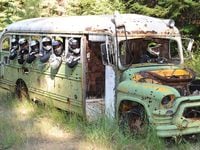We all know Idaho grows plenty of potatoes, but you won’t see a single spud patch along the newly plotted Idaho Backcountry Discovery Route, an all-off-road course across The Gem State designed especially for dual-sport and ADV travel. This is the Idaho you learned about in history class—a place ruled not so long ago by gunslingers and a place where grizzlies and wolves still have plenty of space to wander free. The frontier spirit is strong in Idaho, and you won’t take that for granted if you ride a motorcycle through the heart of it.
It’s not just the endless wilderness that makes Idaho feel this way. Tiny towns that dot the backcountry seem equally lost in time—and not in a bad way. Aside from being surviving examples of the early American pioneer dream, these outposts are perfect places to supply motorcycle travelers. In fact, without these outposts, journeys like this would not be possible; supporting these rural businesses is a strategic mission of the BDR organization, a Seattle-based non-profit entering its fifth season of supplying adventurous motorcyclists with the resources—including GPS tracks, maps, and videos—to cross a state using as little pavement as possible.
This latest BDR segment follows previous projects in Arizona, Utah, Washington, and Colorado and now makes possible an almost-all-dirt route from the Mexican to the Canadian border following some of the best adventure-ready roads in the country. The dedicated, all-volunteer BDR team spent more than a year scouting and piecing together the proposed passage through Idaho. With film crew in tow, the lead expedition spent nearly two weeks verifying the proposed route and putting the finishing touches on what they claim is the wildest BDR yet.
The IDBDR actually begins in Nevada, in the small village of Jarbidge, tucked away in a narrow canyon just south of the Idaho border. Jarbidge claims to be home to a giant cannibal named Tsawhawbitts (tuh-saw-haw-bits), though the few locals who live here don’t seem to worry about him too much. They go about their days supplying visitors with warm meals and cold beers in between taking care of the original buildings along the narrow dirt main street. The jailhouse, for example, still has the original desk and chairs used to book outlaws like Ben Kuhl, who supposedly pulled the last stagecoach robbery in the United States just down the canyon back in 1916.
Heading north begins a 1,300-mile journey that ends, fittingly, under the stars and stripes waving at Port Hill along the Idaho/Canada border. Given our filming and photography obligations and the demands of traveling with a large-ish group of eight riders, it took our scouting party 13 days to complete this journey. You could do it faster, but that’s not recommended if you really want to soak in everything Idaho’s backcountry has to offer.
The Idaho route is probably the least technical of all the BDRs, following mostly smooth forest service roads through dense trees and mountainous terrain—but that’s not to say it is without challenges. We were reminded on our first day riding that even tame gravel roads present risks, when one rider crashed on a gradual corner along a smooth dirt road. It was a low-speed high-side, and with the traction control turned off on his KTM 1190R there was apparently little he could do to save it. It took the better part of a day—and a helicopter—to extract him from the backcountry.
Risky business aside, the journey across Idaho is a spectacular one. After crossing the Snake River at Glenns Ferry along Interstate 84 in the southern part of the state, we began a long trek through a perplexing web of dirt roads, proving that a trusty GPS device as well as a good physical map like the one that Butler Maps makes for the BDRs are both essential for not getting lost.
Despite time spent building a helicopter-landing pad, we still managed to ride 200 miles on day one. We also lucked out on a prime lakeside camp spot along Trinity Lake straight east of Boise. With a pannier full of flank steak and tortillas we were able to make a perfect meal for reflecting on the day’s experience. Fireside benchracing with friends is one of the best parts of backcountry motorcycle travel.
North from Trinity Lake the real flavor of Idaho begins to emerge. Remote only begins to describe it. Small villages like Yellow Pine, Warren, and Burgdorf Hot Springs do very little to pull you from a sense of being disconnected from the rest of the world. Forget about cell service or checking email. (Yes!) Set your auto-reply and turn off the phone; it’s worthless out here. Which is totally fine—who needs any distractions when cold whiskey and blazing hot springs await you at the end of a day’s ride?
The IDBDR skirts two of the largest intact wilderness areas in the country, the Frank Church—River of No Return and Selway-Bitterroot Wilderness. These massive expanses of land are not accessible to motorized vehicles, which limits options for riding through the midsection of the state. To address this, the IDBDR route incorporates the famous Magruder Corridor. This unimaginably beautiful, single-lane dirt road cuts across Idaho toward Montana through an undeveloped area of land twice as large as Delaware and Rhode Island combined. Officially built in the 1930s by the Civilian Conservation Corps, the basic path was used long before that by folks like Lloyd Magruder, who was famously murdered along the route in 1863. His assailants later met their fate by the noose in what was the first legal hanging in the Idaho Territory.
“The Magruder” adds roughly 120 miles to the route and requires an additional pavement slog through Montana to get back into Idaho, but missing an opportunity to ride one of America’s wildest roads would fail a major mission of the BDR group: to expose people to the best places to ride adventure bikes in the United States. Not to mention, the road back into Idaho—The Lolo Motorway—is equally stunning and arguably more historical.
The Lolo Motorway is a 119-mile dirt road that runs between Lolo, Montana, and Pierce, Idaho, across the Bitterroot Mountains. Like the Magruder to the south, the scenery and sense of isolation is unprecedented. Also like the Magruder, famous pioneers and Native Americans used the route, including Lewis and Clark, who were guided through here by Old Toby the Shoshone on their westward journey in September of 1805. We did not have a Shoshone guide and luckily did not battle snow drifts like they did, but we were fortunate enough to be accompanied by a history professor for our day’s journey across the motorway. Taking time to stop at places like the Indian Post Office to get some expert knowledge on the rich history of this area was a welcome change of pace.
From the end of the Lolo Motorway there still remains more than 300 miles of riding through the Idaho panhandle to the Canadian border. It is very similar to the southern part of the state with a few great surprises along the way, including the Blue Cabin between Pierce and Wallace. The Blue Cabin is a private backcountry hut painted—you guessed it—blue. The color is unique in itself, but the real awesomeness is that it’s open, free to the public, on a first-come-first-served basis. No key, no lock, no booking ahead. Just show up and hope you did not get beat to the punch. We rolled the dice and arrived late in the evening to discover that nobody had made claim to the cabin before us, a true relief with rain beginning to fall.
This is no Ritz in the woods, but it does at least have running water and a killer vintage wood-fired stove. If you don’t mind a little dust, there are four beds with real mattresses to choose from and even a (kind of) hot shower. If you’re afraid of ghosts, though, you might feel more comfortable in a tent outside. Our crusty group of travelers was more than happy to cook a meal under a roof and watch the sun go down from the deck, with a little nutritional assistance from BDR’s scouting director Rob Watt and his signature “T-Bobby Robby Cucumber Surprise” consisting of sliced cucumber, cream cheese, and shaved ham. Find the recipe—along with a few more fireside favorites—on the BDR website at backcountrydiscoveryroutes.com.
As mentioned, the IDBDR is not technical, but it is grueling. Day after day of twisty, dusty dirt roads can still be taxing on the brain. By now the miles began to take their toll, especially after a fatal puncture in my sleeping pad prevented good sleep since day two. Fortunately, as you travel up the panhandle, the towns along the way get a bit more modern. Wallace, for example, has managed to get every building on its quaint paved main street on to the National Register of Historic Places. It also managed to throw a few great restaurants into several of them, which is a welcome treat for those weary of freeze-dried road food. From there, more beautiful riding splits the gap between Washington and Montana and skirts the Kootenai National Wildlife Refuge before arriving at the last stop: Port Hill and its friendly Canadian border patrollers.
When it comes to marking the best backcountry routes, nothing beats local knowledge. The IDBDR was prepared with much assistance from Bill Whitacre, an impressively well-connected Idaho adventure enthusiast, along with Kurt Forget from Black Dog Cycles in Sandpoint, Idaho. Between the two of them, the BDR committee gained incredible insight into the state of Idaho, its land, politics, history, and, most important, the best places to ride. Watching the sun dip low along the Pack River at Kurt’s house just south of the border was a great opportunity to remember why projects like this are so important. It brings riders together and it challenges them, but more importantly it creates opportunity for folks who would otherwise stay at home.
With the plethora of ADV bikes and accessories available on the market, wandering around the backcountry on a big motorcycle has become more accessible than ever, but getting out there is still a big leap for many riders raised on the blacktop. Backcountry Discovery Routes make this leap less intimidating. With five states already completed and New Mexico slated for 2016, BDR has more than enough resources to keep you busy in the Western states for years. Want to support the group and help protect and promote the future of two-wheeled adventure travel in the United States? Become a BDR member—several levels of commitment are available, and you’ll be joining a committed group of enthusiasts who honestly care about access, information, and adventure-motorcycle travel. Then use the BDR resources to start planning your next expedition, and save room in your pannier for some real food too.























/cloudfront-us-east-1.images.arcpublishing.com/octane/QSTCM6AVEZA5JJBUXNIQ3DSOF4.jpg)
/cloudfront-us-east-1.images.arcpublishing.com/octane/U4I7G625B5DMLF2DVIJDFZVV6M.jpg)
/cloudfront-us-east-1.images.arcpublishing.com/octane/B6XD6LS6IVCQPIU6HXDJSM3FHY.jpg)
/cloudfront-us-east-1.images.arcpublishing.com/octane/ICL63FEDDRDTTMINYICCEYGMDA.jpg)
/cloudfront-us-east-1.images.arcpublishing.com/octane/FCGZHQXRBZFLBAPC5SDIQLVF4I.jpg)
/cloudfront-us-east-1.images.arcpublishing.com/octane/WNOB6LDOIFFHJKPSVIWDYUGOPM.jpg)

/cloudfront-us-east-1.images.arcpublishing.com/octane/X33NU3E525ECRHXLNUJN2FTRKI.jpg)
/cloudfront-us-east-1.images.arcpublishing.com/octane/6KKT5NNL2JAVBOXMZYS5ZO76YA.jpg)
/cloudfront-us-east-1.images.arcpublishing.com/octane/J5RKG5O455GMPGQRF2OG6LRT7A.jpg)
/cloudfront-us-east-1.images.arcpublishing.com/octane/GX2CIZKQVRH2TATDM26KFG2DAE.jpg)
/cloudfront-us-east-1.images.arcpublishing.com/octane/ZWIDYSAKQZHD5BHREMQILXJCGM.jpg)
/cloudfront-us-east-1.images.arcpublishing.com/octane/CYUHJZCTSJCH3MRAQEIKXK7SCQ.jpg)
/cloudfront-us-east-1.images.arcpublishing.com/octane/LKOFINY56FCXJCANJ5M7ZDQUBY.jpg)
/cloudfront-us-east-1.images.arcpublishing.com/octane/4NBPDACMWJH63JQYJVK3QRBDZI.jpg)
/cloudfront-us-east-1.images.arcpublishing.com/octane/KKHQHRR3FJGX7H2IPU6RALMWG4.jpg)

/cloudfront-us-east-1.images.arcpublishing.com/octane/5IOFS5JAE5FOXMNA23ZRAVVYUU.jpg)
/cloudfront-us-east-1.images.arcpublishing.com/octane/CGXQ3O2VVJF7PGTYR3QICTLDLM.jpg)

/cloudfront-us-east-1.images.arcpublishing.com/octane/OQVCJOABCFC5NBEF2KIGRCV3XA.jpg)
/cloudfront-us-east-1.images.arcpublishing.com/octane/OPVQ7R4EFNCLRDPSQT4FBZCS2A.jpg)
/cloudfront-us-east-1.images.arcpublishing.com/octane/YBPFZBTAS5FJJBKOWC57QGEFDM.jpg)
/cloudfront-us-east-1.images.arcpublishing.com/octane/W5DVCJVUQVHZTN2DNYLI2UYW5U.jpg)